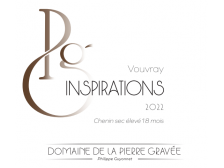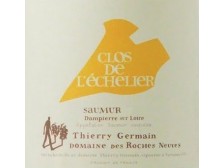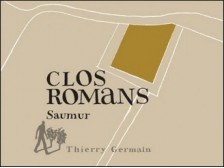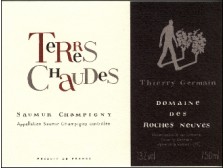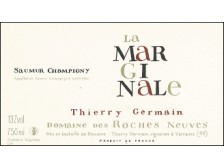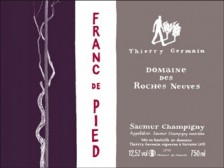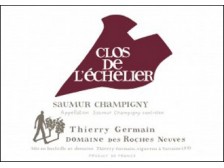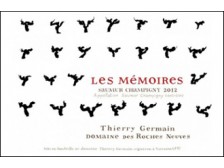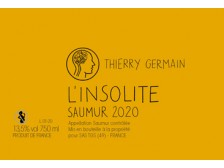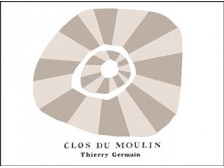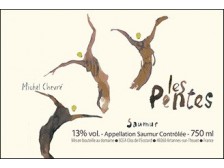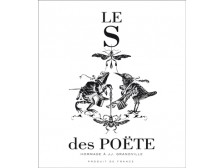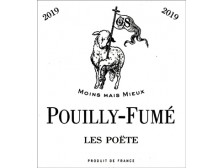Catalog
-
A lifelong wine lover, Philippe Guyonnet took the plunge in 2021 by purchasing 9 hectares in Vouvray, on the advice of his friend and mentor Jacky Blot (La Taille aux Loups). With his attention to detail, he immediately opted for organic viticulture, manual harvesting and fermentation with indigenous yeasts in small containers (amphorae and barrels) . From his time in the Mâconnais region, he retains a taste for long ageing (18 to 30 months), which he finishes with bottling without fining or filtration. His Chenin wines, vinified exclusively as dry wines, have a beautiful aromatic richness (chamomile, white peach, vanilla, etc.) and a richness that is perfectly balanced by a lively acidity. 2022 is his first vintage, and already a masterstroke. Everything is in place for this estate to quickly make a name for itself.
Made from vines aged 50 years and older, grown on flinty clay soil, Inspirations (aged for 18 months) is characterised by its finesse and liveliness.
More- To keep or to drink:
- Ready to drink
- Apogée:
- 2025-2030
- Organic certification:
- 2024
- More
- To keep or to drink:
- Wait 1 to 2 years
- Apogée:
- 2026-2035
- Organic certification:
- 2024
-
This is the domain which, by its passage into biodynamic viticulture and its parcel selections, shows the most beautiful qualitative progression of the Loire Valley. Crystalline Chenins and ripe Cabernet Franc, all matured with mastery to sublimate the purity and identity of the juices, between tension, crispness, refinement and generosity. In white as in red, a dazzling and flawless range.
Rated three stars in the Revue du Vin de France guide.The 2021 vintage in the press:
Vinous (R. Gibb - May 2024) : 92/100 "Don't mess with the 2021 Saumur blanc L'Échelier: it's got attitude–flirty, floral and transparent, with the purity of a glacier. The Germains didn't do any malolactic despite the natural acidity of this vintage. This is an acid fiend's wine, but it's ripe phenolics give real firmness, like a fierce girl. Melon and apple flavors linger on the very pure and strict conclusion."
More- To keep or to drink:
- Ready to drink
- Apogée:
- 2025-2032
- Organic certification:
- 2004
-
This is the domain which, by its passage into biodynamic viticulture and its parcel selections, shows the most beautiful qualitative progression of the Loire Valley. Crystalline Chenins and ripe Cabernet Franc, all matured with mastery to sublimate the purity and identity of the juices, between tension, crispness, refinement and generosity. In white as in red, a dazzling and flawless range.
Rated three stars in the Revue du Vin de France guide.The 2020 vintage in the press:
Vinous (R. Gibb - May 2024) : 91/100 "There's a richness to the 2020 Saumur blanc L'Échelier that reflects the dry, warm conditions of the vintage. Ripe and tropical yet saline with notes of almond meal, it's already beginning to develop. The 2020 rampages to retain its freshness despite the exotic fruit."
More- To keep or to drink:
- Ready to drink
- Apogée:
- 2025-2032
- Organic certification:
- 2004
-
This is the domain which, by its passage into biodynamic viticulture and its parcel selections, shows the most beautiful qualitative progression of the Loire Valley. Crystalline Chenins and ripe Cabernet Franc, all matured with mastery to sublimate the purity and identity of the juices, between tension, crispness, refinement and generosity. In white as in red, a dazzling and flawless range.
Rated three stars in the Revue du Vin de France guide.The 2019 vintage in the press :
Vinous (R. Gibb - July 2024) : 95/100 "The 2019 Saumur blanc L'Échelier is dense, concentrated and ripe yet harnessed, with excellent power and purity coursing through its veins. It's salty and tangy, bone-dry and firm. The 2019 is my favorite vintage of the past decade."
More- To keep or to drink:
- Ready to drink
- Apogée:
- 2021-2028
- Organic certification:
- 2004
- Potential alcohol:
- 13.5%
-
This is the domain which, by its passage into biodynamic viticulture and its parcel selections, shows the most beautiful qualitative progression of the Loire Valley. Crystalline Chenins and ripe Cabernet Franc, all matured with mastery to sublimate the purity and identity of the juices, between tension, crispness, refinement and generosity. In white as in red, a dazzling and flawless range.
Rated three stars in the Revue du Vin de France guide.The 2018 vintage in the press :
Vinous (R. Gibb - July 2024) : 92/100 « The 2018 Saumur blanc L'Échelier is dry, round, nutty and tropical. It was a very warm vintage, giving richness and ripe pineapple character. A racy acidity holds this wine together like tight reins. There's a contrast here between that tropicality and the zingy, crunchy acidity, which messes with your head. »
More- To keep or to drink:
- Ready to drink
- Apogée:
- 2020-2030
- Organic certification:
- 2004
- Potential alcohol:
- 13.5%
-
This is the domain which, by its passage into biodynamic viticulture and its parcel selections, shows the most beautiful qualitative progression of the Loire Valley. Crystalline Chenins and ripe Cabernet Franc, all matured with mastery to sublimate the purity and identity of the juices, between tension, crispness, refinement and generosity. In white as in red, a dazzling and flawless range.
Rated three stars in the Revue du Vin de France guide.The 2017 vintage in the press :
Vinous (R. Gibb - July 2024) : 93/100 "The golden-hued 2017 Saumur blanc L'Échelier shows ripe flavors of pineapple, honey and truffle, almost as if there's some botrytis–but there's not. It's bone-dry, yet there's a tender middle to this light-bodied wine. Expect iodine, giving a salty-like-the-sea impression. The 2017 is ready to enjoy now."
More- To keep or to drink:
- Ready to drink
- Apogée:
- 2021-2028
- Organic certification:
- 2004
- Potential alcohol:
- 13%
-
This is the domain which, by its passage into biodynamic viticulture and its parcel selections, shows the most beautiful qualitative progression of the Loire Valley. Crystalline Chenins and ripe Cabernet Franc, all matured with mastery to sublimate the purity and identity of the juices, between tension, crispness, refinement and generosity. In white as in red, a dazzling and flawless range.
Rated three stars in the Revue du Vin de France guide.The 2016 vintage in the press:
Vinous (R. Gibb - July 2024) : 92/100 "Like a good aged Riesling, the 2016 Saumur blanc L'Échelier offers up toast, marmalade, honey and is there the slightest hint of petrol here? A bit less evolved on the palate then on the nose, ot gives off a charming citrus freshness, but I'd love a little more depth."
More- To keep or to drink:
- Ready to drink
- Apogée:
- 2019-2028
- Organic certification:
- 2004
- Potential alcohol:
- 12.5%
-
This is the domain which, by its passage into biodynamic viticulture and its parcel selections, shows the most beautiful qualitative progression of the Loire Valley. Crystalline Chenins and ripe Cabernet Franc, all matured with mastery to sublimate the purity and identity of the juices, between tension, crispness, refinement and generosity. In white as in red, a dazzling and flawless range.
Rated three stars in the Revue du Vin de France guide.The 2022 vintage in the press:
La Revue du Vin de France (April 2025): 95/100 "From a delightful clos with soils of clay, silt, sandstone and flint on tufa, here is Clos Romans, a radiant white evoking flowers and citrus fruit, full of nuances. Magnificent purity of substance. Exceptional drive and unforgettable freshness in this sunny vintage."
Vinous (Rebecca Gibb - May 2024) : 94/100 "The 2022 Saumur blanc Clos Romans is focused, concentrated and powerful, displaying floral, pear and melon aromas. It's a structured style, creating a picture frame within which the wine sits. Intriguing with long, apple-infused length, this wine has an identity and is proud of it."
More- To keep or to drink:
- Wait 3 to 5 years
- Apogée:
- 2029-2041
- Organic certification:
- 2004
-
This is the domain which, by its passage into biodynamic viticulture and its parcel selections, shows the most beautiful qualitative progression of the Loire Valley. Crystalline Chenins and ripe Cabernet Franc, all matured with mastery to sublimate the purity and identity of the juices, between tension, crispness, refinement and generosity. In white as in red, a dazzling and flawless range.
Rated three stars in the Revue du Vin de France guide.The 2021 vintage in the press:
Vinous (R. Gibb - June 2023): 94/100 “The 2021 Clos Romans peaceful entry starts as if it has repented for its sins, but don't be fooled: this dry style has a fierce arrow-loke line of acidity and tension penetrating the win's core. In its precise and tense youth, this aromatically restrained wine offers subtle florals, quince and less-derived notes, but it needs time to unfurl, relax and blossom.”
La Revue du Vin de France (J. Cukierman - April 2024): 96-97/100 “A dry and straight wine, but very charming in its aromatic palette with fresh almond and lemon bergamot [...] It offers great tension, a very pure structure and takes us into its marine and iodized universe”.
La Revue du Vin de France (A. Goujard - April 2024): 95/100 “It evokes fresh almond and pineapple. Invigorating aromatic vitality. Chiseled substance on the palate, a magnificent flowing, intense texture. The fatness builds slowly to an extremely salivating finish. Luminous !”
More- To keep or to drink:
- Wait 3 to 5 years
- Apogée:
- 2028-2039
- Organic certification:
- 2004
-
This is the domain which, by its passage into biodynamic viticulture and its parcel selections, shows the most beautiful qualitative progression of the Loire Valley. Crystalline Chenins and ripe Cabernet Franc, all matured with mastery to sublimate the purity and identity of the juices, between tension, crispness, refinement and generosity. In white as in red, a dazzling and flawless range.
Rated three stars in the Revue du Vin de France guide.More- To keep or to drink:
- Wait 1 to 2 years
- Apogée:
- 2026-2035
- Organic certification:
- 2004
-
This is the domain which, by its passage into biodynamic viticulture and its parcel selections, shows the most beautiful qualitative progression of the Loire Valley. Crystalline Chenins and ripe Cabernet Franc, all matured with mastery to sublimate the purity and identity of the juices, between tension, crispness, refinement and generosity. In white as in red, a dazzling and flawless range.
Rated three stars in the Revue du Vin de France guide.The 2022 vintage in the press:
Vinous (R. Gibb - July 2024): 92/100 “The 2022 Terres Chaudes offers silky substance and something to get your teeth into despite its elegance and finesse. As ever, there's pure fruit, harmony and bite. A firmness to the tannins appears right at the end, lending structure that gives the wine frame."
More- To keep or to drink:
- Ready to drink
- Apogée:
- 2025-2034
- Organic certification:
- 2004
-
This is the domain which, by its passage into biodynamic viticulture and its parcel selections, shows the most beautiful qualitative progression of the Loire Valley. Crystalline Chenins and ripe Cabernet Franc, all matured with mastery to sublimate the purity and identity of the juices, between tension, crispness, refinement and generosity. In white as in red, a dazzling and flawless range.
Rated three stars in the Revue du Vin de France guide.The 2021 vintage in the press:
Vinous (R. Gibb - December 2023): 89/100 “The 2021 Terres Chaudes is a highly aromatic, light-bodied style although there is a touch of juiciness through the mid-palate. True to its vintage, there's no doubting the refreshing acidity and the touch of herbal in the flavor profile. The tannins are well handled, and the fruit is pure and adulterated, as well as lightly spiced."
More- To keep or to drink:
- Ready to drink
- Apogée:
- 2024-2032
- Organic certification:
- 2004
-
This is the domain which, by its passage into biodynamic viticulture and its parcel selections, shows the most beautiful qualitative progression of the Loire Valley. Crystalline Chenins and ripe Cabernet Franc, all matured with mastery to sublimate the purity and identity of the juices, between tension, crispness, refinement and generosity. In white as in red, a dazzling and flawless range.
Rated three stars in the Revue du Vin de France guide.More- To keep or to drink:
- Ready to drink
- Apogée:
- 2020-2028
- Organic certification:
- 2004
- Potential alcohol:
- 12.5%
-
This is the domain which, by its passage into biodynamic viticulture and its parcel selections, shows the most beautiful qualitative progression of the Loire Valley. Crystalline Chenins and ripe Cabernet Franc, all matured with mastery to sublimate the purity and identity of the juices, between tension, crispness, refinement and generosity. In white as in red, a dazzling and flawless range.
Rated three stars in the Revue du Vin de France guide.More- To keep or to drink:
- Ready to drink
- Apogée:
- 2025-2035
- Organic certification:
- 2004
-
This is the domain which, by its passage into biodynamic viticulture and its parcel selections, shows the most beautiful qualitative progression of the Loire Valley. Crystalline Chenins and ripe Cabernet Franc, all matured with mastery to sublimate the purity and identity of the juices, between tension, crispness, refinement and generosity. In white as in red, a dazzling and flawless range.
Rated three stars in the Revue du Vin de France guide.More- To keep or to drink:
- Ready to drink
- Apogée:
- 2022-2032
- Organic certification:
- 2004
- Potential alcohol:
- 13.5%
-
This is the domain which, by its passage into biodynamic viticulture and its parcel selections, shows the most beautiful qualitative progression of the Loire Valley. Crystalline Chenins and ripe Cabernet Franc, all matured with mastery to sublimate the purity and identity of the juices, between tension, crispness, refinement and generosity. In white as in red, a dazzling and flawless range.
Rated three stars in the Revue du Vin de France guide.Rated 17/20 by M. Bettane and 17.5/20 by the Revue du Vin de France (February 2019) "its velvety texture gives it a sublime fullness of fruit and an invigorating length on the palate [...] With a singular definition, Ma Marginale even evokes an airy balance of beautiful Burgundian pinot noir".
More- To keep or to drink:
- Ready to drink
- Apogée:
- 2020-2030
- Organic certification:
- 2004
- Potential alcohol:
- 12.5%
-
This is the domain which, by its passage into biodynamic viticulture and its parcel selections, shows the most beautiful qualitative progression of the Loire Valley. Crystalline Chenins and ripe Cabernet Franc, all matured with mastery to sublimate the purity and identity of the juices, between tension, crispness, refinement and generosity. In white as in red, a dazzling and flawless range.
Rated three stars in the Revue du Vin de France guide.La Marginale is the cuvée of reference for the red wines of the Domaine des Roches Neuves, 100% Cabernet Franc facing south on deep limestone.
More- To keep or to drink:
- Ready to drink
- Apogée:
- 2020-2028
- Organic certification:
- 2004
- Potential alcohol:
- 13%
-
This is the domain which, by its passage into biodynamic viticulture and its parcel selections, shows the most beautiful qualitative progression of the Loire Valley. Crystalline Chenins and ripe Cabernet Franc, all matured with mastery to sublimate the purity and identity of the juices, between tension, crispness, refinement and generosity. In white as in red, a dazzling and flawless range.
Rated three stars in the Revue du Vin de France guide.La Marginale is the cuvée of reference for the red wines of the Domaine des Roches Neuves, 100% Cabernet Franc facing south on deep limestone.
More- To keep or to drink:
- Ready to drink
- Apogée:
- 2016-2028
- Organic certification:
- 2004
- Potential alcohol:
- 12.5%
-
This is the domain which, by its passage into biodynamic viticulture and its parcel selections, shows the most beautiful qualitative progression of the Loire Valley. Crystalline Chenins and ripe Cabernet Franc, all matured with mastery to sublimate the purity and identity of the juices, between tension, crispness, refinement and generosity. In white as in red, a dazzling and flawless range.
Rated three stars in the Revue du Vin de France guide.The 2020 vintage in the press :
Vinous (R. Gibb - June 2022): 94/100 "The 2020 Franc de Pied [...] reveals itself to be a richly fruited, savory style that fills the mouth with a balloon of chalky silness. The limestone element really shows itself on the long finish, all finely grained texture and sinew. As you'd hope from Saumur-Champigny, there's no sense of weight or heft."
More- To keep or to drink:
- Wait 1 to 2 years
- Apogée:
- 2026-2038
- Organic certification:
- 2004
-
This is the domain which, by its passage into biodynamic viticulture and its parcel selections, shows the most beautiful qualitative progression of the Loire Valley. Crystalline Chenins and ripe Cabernet Franc, all matured with mastery to sublimate the purity and identity of the juices, between tension, crispness, refinement and generosity. In white as in red, a dazzling and flawless range.
Rated three stars in the Revue du Vin de France guide.The 2021 vintage in the press:
Vinous (R. Gibb - December 2023): 92/100 “The 2021Clos de l'Echelier is a delicate and tender style, with impressive purity of fruit. It is almost cloud-like in its lightness on the palate. The finest of chalk-like tannins covers the mouth in a blanket of finely-pixelated image, which can no doubt be attributed to this limestone-rich, north-facing site as well as a very delicate hand when it comes to extraction. Being 2021, there's no shortage of acidity, but it is entirely integrated within the wine, providing a thread of tension that courses through its core, leaving everything tied up on the precise finish. This is a harmonious,well-crafted example."
More- To keep or to drink:
- Wait 1 to 2 years
- Apogée:
- 2026-2037
- Organic certification:
- 2004
-
This is the domain which, by its passage into biodynamic viticulture and its parcel selections, shows the most beautiful qualitative progression of the Loire Valley. Crystalline Chenins and ripe Cabernet Franc, all matured with mastery to sublimate the purity and identity of the juices, between tension, crispness, refinement and generosity. In white as in red, a dazzling and flawless range.
Rated three stars in the Revue du Vin de France guide.More- To keep or to drink:
- Ready to drink
- Apogée:
- 2024-2033
- Organic certification:
- 2004
- Potential alcohol:
- 13.5%
-
This is the domain which, by its passage into biodynamic viticulture and its parcel selections, shows the most beautiful qualitative progression of the Loire Valley. Crystalline Chenins and ripe Cabernet Franc, all matured with mastery to sublimate the purity and identity of the juices, between tension, crispness, refinement and generosity. In white as in red, a dazzling and flawless range.
Rated three stars in the Revue du Vin de France guide.Rated 18/20 by BETTANE & DESSEAUVE
More- To keep or to drink:
- Ready to drink
- Apogée:
- 2021-2030
- Organic certification:
- 2004
- Potential alcohol:
- 13%
-
This is the domain which, by its passage into biodynamic viticulture and its parcel selections, shows the most beautiful qualitative progression of the Loire Valley. Crystalline Chenins and ripe Cabernet Franc, all matured with mastery to sublimate the purity and identity of the juices, between tension, crispness, refinement and generosity. In white as in red, a dazzling and flawless range.
Rated three stars in the Revue du Vin de France guide.The 2021 vintage in the press:
Vinous (Rebecca Gibb - Master of Wine - December 2023): 94/100 “Made from vines planted on clay-limestone in 1904, Les Mémoires 2021 is fragrant, refined and long. It displays rich concentration in an elegant, rather delicate whole. As expected with a wine of this age, it's young and bright, with aromas of red currant fruit, flowers, black olive and even a hint of smoky wood. There's definitely depth and tannins, but they melt away on the palate. The finish is refined and assured, with a shimmering acidity that gives it a fabulous backbone. Apogee 2024-2038.”
More- To keep or to drink:
- Wait 5 to 10 years
- Apogée:
- 2030-2042
- Organic certification:
- 2004
-
The Domaine des Roches Neuves is the estate which, through its transition to biodynamic viticulture and its parcel selections, shows the most beautiful qualitative progression in the Loire Valley. Crystalline Chenins and ripe Cabernet Franc, all matured with mastery to sublimate the purity and identity of the juices, between tension, crispness, refinement and generosity. In white as in red, a dazzling and flawless range.
Rated three stars in the Revue du Vin de France guide.
L'Insolite is produced under the name of Thierry Germain, owner of the Domaine des Roches Neuves.More- To keep or to drink:
- Ready to drink
- Apogée:
- 2025-2030
-
The Domaine des Roches Neuves is the estate which, through its transition to biodynamic viticulture and its parcel selections, shows the most beautiful qualitative progression in the Loire Valley. Crystalline Chenins and ripe Cabernet Franc, all matured with mastery to sublimate the purity and identity of the juices, between tension, crispness, refinement and generosity. In white as in red, a dazzling and flawless range.
Rated three stars in the Revue du Vin de France guide.
Clos du Moulin is produced under the name of Thierry Germain, owner of the Domaine des Roches Neuves.More- To keep or to drink:
- Ready to drink
- Apogée:
- 2020-2026
-
The Domaine des Roches Neuves is the estate which, through its transition to biodynamic viticulture and its parcel selections, shows the most beautiful qualitative progression in the Loire Valley. Crystalline Chenins and ripe Cabernet Franc, all matured with mastery to sublimate the purity and identity of the juices, between tension, crispness, refinement and generosity. In white as in red, a dazzling and flawless range.
Rated three stars in the Revue du Vin de France guide.
Les Pentes is produced under the name of Michel Chevré, the vineyard manager of the Domaine des Roches Neuves for more than 20 years.Michel CHEVRÉ a travaillé aux côtés de Thierry GERMAIN en tant que chef de culture du Domaine des Roches Neuves. Depuis 2007, en collaboration avec Thierry GERMAIN, il élabore sur 3 ha sur une butte calcaire plein sud, deux grands chenins en culture biologique : Clos de l'Écotard et Les Pentes.
« Doté d'une formidable trame saline et ferme, c'est une boule de nerf de chenin mûr. » noté 17/20 par la Revue du Vin de France.
More- To keep or to drink:
- Ready to drink
- Apogée:
- 2021-2028
- Potential alcohol:
- 13%
-
With 7 hectares spread over 28 plots of land that look like gardens, Guillaume Sorbe is an unrivalled goldsmith. In his two appellations, Quincy and Reuilly, in the Cher valley, he crafts formidable wines, both whites (Sauvignon) and reds (Pinot Noir), aesthetically pleasing wines that are both savoury and mineral, bold and taut. His excellence has already been recognised: "Winemaker of the Year 2018" by the Revue du Vin de France, and listed in the "Top 10" of the best producers in the 2019 Bettane&Desseauve guide.
Domaine rated two stars in the Revue du Vin de France annual guide.
More- To keep or to drink:
- Ready to drink
- Apogée:
- 2024-2029
-
With 7 hectares spread over 28 plots held like gardens, Guillaume Sorbe is an outstanding goldsmith. On its two appellations Quincy and Reuilly in the Cher valley, it chisels fantastic wines, white (sauvignon) and red (pinot noir), esthetic wines that are both tasty and mineral, fat and tense. His excellence is already recognized: "Winemaker of the year 2018" for the Revue du Vin de France, and cited in the Top 10 of the best producers in the Bettane&Desseauve 2019 guide.
Pouilly-Fumé: Sauvignon on two terroirs: half caillotte (small limestone pebbles) and half flint. The most tense wine of the cellar, mineral and salty as desired.
Domaine rated two stars in the Revue du Vin de France annual guide.
More- To keep or to drink:
- Wait 1 to 2 years
- Apogée:
- 2026-2035
-
With 7 hectares spread over 28 plots held like gardens, Guillaume Sorbe is an outstanding goldsmith. On its two appellations Quincy and Reuilly in the Cher valley, it chisels fantastic wines, white (sauvignon) and red (pinot noir), esthetic wines that are both tasty and mineral, fat and tense. His excellence is already recognized: "Winemaker of the year 2018" for the Revue du Vin de France, and cited in the Top 10 of the best producers in the Bettane&Desseauve 2019 guide.
Pouilly-Fumé: Sauvignon on two terroirs: half caillotte (small limestone pebbles) and half flint. The most tense wine of the cellar, mineral and salty as desired.
Domaine rated two stars in the Revue du Vin de France annual guide.
The 2022 vintage in the press:
La Revue du Vin de France (Guide 2024) : 90/100 "The Pouilly-Fumé also offers real fruity tenderness in 2022, delicately exotic without being excessive; the finish is well-structured and sculpted by subtle bitter notes."
More- To keep or to drink:
- Wait 1 to 2 years
- Apogée:
- 2026-2035



